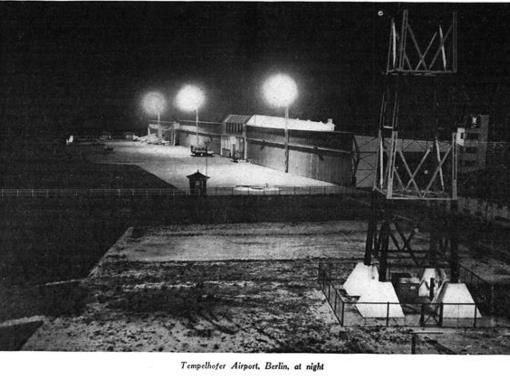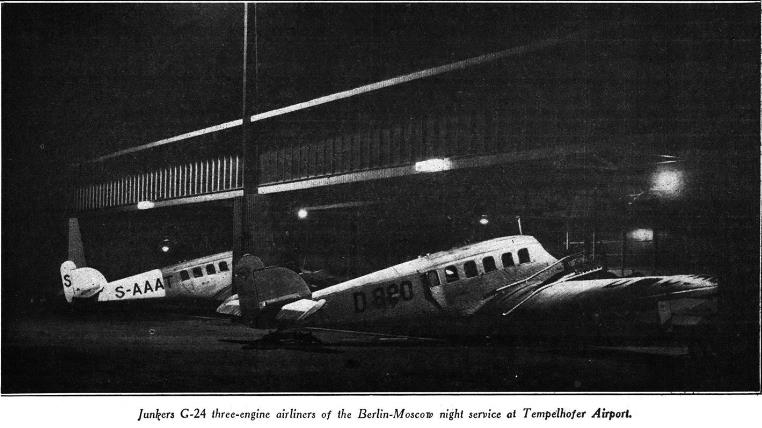Berlin-Koenigsberg Night Airway Fully Lighted. Three-Engine Planes Used
By ERHARDT MILCH
Director of the German Luft Hansa
CLEARLY recognizing that flying at night is one of the main requirements of the future of air transport, the officials of the German Loft Hausa air services have been particularly interested in the development of night flying. In 1924 and 1925, extensive trials were carried out on a number of night routes by the German air transport companies operating at that time. These trials had shown up such excellent results that the new German air transport combine, the Luft Hansa, in the beginning of 1926, started night flying service for passengers. On May 1, the night route Berlin-Danzig-Koenigsberg (over 400 miles) was opened up and carried on regularly until the beginning of the winter service, on Nov. 15. The record attained in these night routes for passenger service during the Summer was splendid. A reliability and punctuality of nearly 100 per cent was achieved. Besides a large number of passengers, a considerable amount of mail, newspapers and freight were carried on this line.
For the first time in Europe everybody could make use of the airplane for traveling at night. All the passengers were thrilled by the wonderful aspect of the illuminated cities at night. They were all enchanted by the advance of huma ability. Based on these good results, the system of night routes will be further extended next year. The new lines will, as in the case of the route B.-D.-K., be equipped with complete night flying illumination.
The night route has been operated with the three-engined Junkers G.24 monoplanes which, for this purpose, were equipped with all modem means of navigation. Besides the compass, every plane was supplied with a Gyrorector and a bank and turn indicator, making it possible) to keep the machines iu straight flight and to steer it with absolute safety, even ou the darkest night. For orientation and landing there are powerful searchlights attached to the wings, receiving their current from a small generator mounted underneath the fuselage. In addition, there are three magnesium flares fastened to the underside of each wing, capable of illuminating the landscape withiu a radius of 1,000-1,500 ft to a brightness equal to daylight, in case of a landing becoming necessary at an emergency field.
Night Flying Instruments
Local fogs are easily avoided by means of a complete wireless telephone system, S. & E. sets, enabling the pilot to receive weather reports and inquire about his position at all times during the flight. The interior illumination of the cockpit is only so bright as not to cause any blinding of the pilot while the passengers* cabin is perfectly illuminated by numerous electric lamps and domelights. A soft violet-blue glow makes all the instruments on the dash visible for easy recognition and reading.
The night illumination of the route admits a perfect orientation along the line. About every 20 miles there are revolving beacons, similar to thOBB DMd in witter navigation. In order to obtain the greatest range possible, these beacons are supplied with silvered parabolic glass reflectors, and in most cases they are hooked up to the high-tonsion power lines. Between these revolving beacons, at intervals of three or four miles, arc placed Neon tubes, giving off an orange col-ored light, thus securely leading the plane from beacon to
beacon, even under the worst conditions of visibility. At each of the beacons there is established an emergency landing field. The Neon tubes mentioned above burn day and night. In addition to these two forms of electric beacons there are, in some locations, where no electric current is available, flashing acetylene beacons.
For airplanes taking off and landing, tho airports are supplied with a large variety of illuminating devices, depending upon the importance of the airport. Tn the first place, there is erected close to each airport a high beacon, visible from all directions. These beacons generally consist of revolving searchlights which, under average conditions of visibility, can be seen at a distance of from 50 to 75 miles. For locating the field itself, there are, in the immediate vicinity, field identification marks, usually consisting of steady burning Neon tubes.
Tempelhofer Airport, Berlin, has on its two radio towers two flashing Neon lights. The actual boundaries of the field are indicated by a continuous line of red lights placed 150 to 200 ft. apart. The spot where the plane should touch the ground is marked out by a line of green, white and red lamps, changing in order of color with the wind direction and burning from dusk to dawn. Besides showing the wind direction, this line of lamps enables the pilot to judge his speed and height above the ground. The landing is made from green over white to red. Thus the red light is to windward and the wind blows in the direction, red, white, green. All ob- structions near or on the field are either marked by red warning lights or brightly illuminated by searchlights.
Terminal Lighting
The Tempelhofer Airport is especially lighted by means of seven ''suns" erected on high surrounding points. The "sun* consists of five electric bulbs, each of 1000 watts. They spread a very agreeable light over the whole field which is alone sufficient for making a safe landing. In addition these lights illuminate the buildings on the airport in a way that they are easily recognized from the air. By means of these "suns" the space in front of the hangars is made as light as day for servicing the machines. Directed only downwards, they have no blinding effect. The Tempelhofer Airport is also equipped with an illuminated wind direction indicator that shows up very well from the air.
Either of these devices the "suns" or the line of green, white and red lamps-is sufficient for landing without any other aid. In addition, as mentioned above, each plane carries complete equipment of landing lights and flares of its own. In this case also, either one of the devices is sufficient for making a perfect landing. Consequently, there is always a quadruple factor of chance in the illumination system during a landing, and the four of them worked together will insure a landing as safe as that in daytime. In this connection it is interesting to mention that every night landing has boon carried out with perfect safety and without the slightest damage whatsoever.





